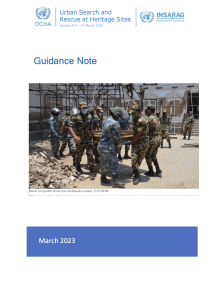
This guide aims to provide practical procedures and critical information for Urban Search and Rescue (USAR) teams, National Disaster Management Authorities (NDMA), Local Emergency Management Authorities (LEMA), Cultural Ministries, Heritage Departments and Authorities (CHA), and Cultural Heritage First Aiders (CFA) involved in operations at heritage sites affected by disasters.
The document emphasizes the importance of effective communication and cooperation between USAR teams and CHA in disaster areas with significant cultural heritage buildings and sites. It outlines the necessary policies, preparedness, and capacities required for providing cultural heritage first aid within the International USAR Response Cycle, ensuring that search and rescue operations in these special operational environments are conducted with the sensitivity and expertise that heritage preservation demands.
By increasing awareness and promoting the safeguarding of heritage immediately following a disaster, especially during search and rescue operations, this guide aims to enhance overall preparedness and foster inter-agency cooperation and coordination between emergency management and cultural heritage sectors. Drawing on the INSARAG Guidelines 2020 and the field-tested methodology developed by ICCROM for cultural heritage first aid, this guide is a valuable resource for international and national USAR teams and LEMA, enabling self-training and improved operational readiness.
The development of this publication has been supported by INSARAG’s Flexible Response Working Group, its sub-Working Group on Cultural Heritage, and subject area experts. The collaborative efforts between INSARAG, UNESCO, ICCROM, ICOMOS-ICORP Turkey, and GEA-SAR highlight the collective commitment to addressing the unique challenges of urban search and rescue operations at heritage sites, ensuring the preservation and protection of cultural heritage in times of crises.
